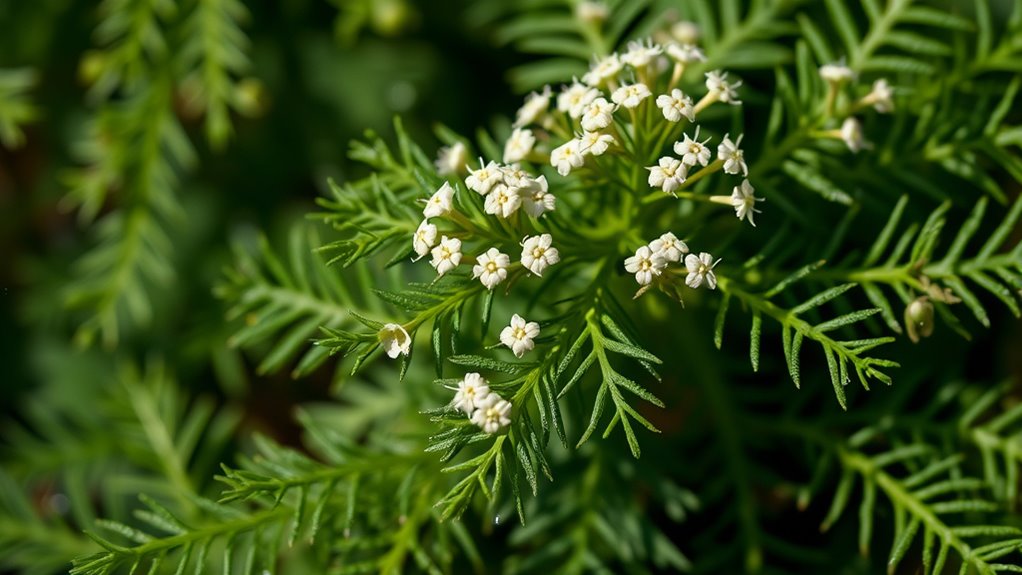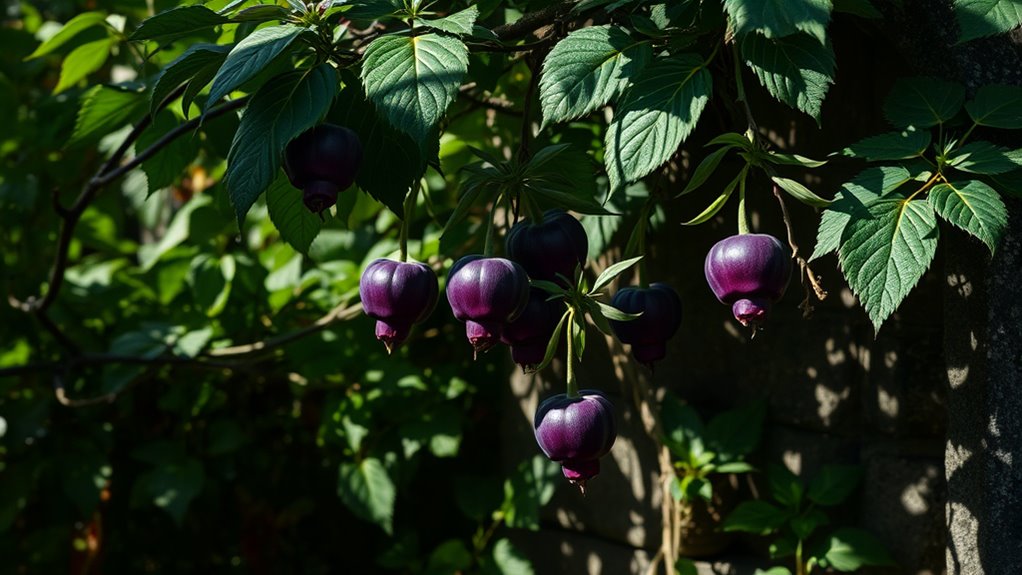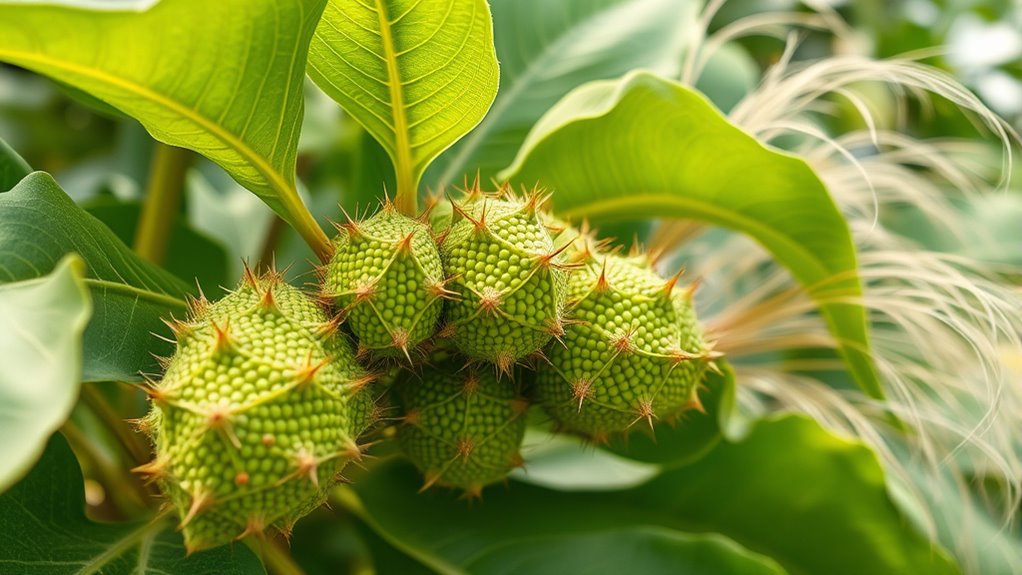Poisonous plants have a long history of turning herbology deadly, playing roles in rituals, medicine, and murder. Famous examples like aconite, hemlock, and belladonna were used to poison enemies or execute prisoners, while others like castor beans and deadly nightshade caused elegant but lethal effects. These plants reveal a dual nature—revered for healing yet feared for their danger. Discover the fascinating secrets behind these toxic wonders and how they shaped history.
Key Takeaways
- Many ancient poisonous plants like hemlock and belladonna were used in rituals, medicine, and executions, illustrating their dual nature.
- Toxic parts such as seeds and berries often concealed lethal doses, making them feared tools of assassination and warfare.
- Notorious examples include Socrates’ death by hemlock and poisonings using aconite in political plots.
- Cultures recognized the plants’ power to heal or harm, employing them cautiously in spiritual and medicinal practices.
- Modern understanding emphasizes the importance of identifying and handling poisonous plants to prevent accidental fatalities.
The Deadly Legacy of Aconite: The Queen’s Poison

Aconite, also known as wolfsbane or monkshood, has a long history as a potent poison used in royal and political intrigue. Its striking flowers hide a deadly secret: high levels of neurotoxins that can cause paralysis and death. Throughout history, it’s been linked to covert assassinations, often chosen for its potency and concealability. You might not realize, but aconite was sometimes used in courtly poisonings to eliminate rivals or even monarchs. Its allure lies not only in its lethal power but also in its subtlety—small doses can be enough to cause symptoms before death. Because of its dangerous nature, it became a symbol of treachery and silent murder, embedding itself into the dark side of aristocratic history.
Hemlock and Socrates: The Herb of Execution

Socrates’ death by hemlock remains one of history’s most infamous examples of judicial execution using poison. This plant, known scientifically as *Conium maculatum*, contains potent toxins that cause paralysis and respiratory failure. Socrates drank a hemlock solution after being sentenced to death, sealing his fate. The herb’s deadly properties have made it a symbol of lethal justice. Here’s a quick overview:
| Aspect | Details |
|---|---|
| Active Toxins | Coniine, Noconicine |
| Effects | Paralysis, respiratory failure |
| Historical Use | Execution, assassination |
| Notable Victim | Socrates |
Hemlock’s lethal reputation endures, reminding us of how herbology can turn deadly when misused.
Belladonna: Beauty and the Baneful Bloom

Belladonna has a dark history of both poisoning and medicinal use, mesmerizing and terrifying those who encountered it. Its toxic reputation grew from famous poisonings, yet today, it plays a role in modern medicine. You’ll see how this deadly beauty continues to influence both past and present.
Historical Poisonings and Uses
Have you ever wondered how a plant known for its striking beauty could also be deadly? Belladonna, or deadly nightshade, was historically used for poisonings and medical treatments. Ancient Romans and Greeks prized its intoxicating effects, often using it as a poison for assassinations or executions. During the Middle Ages, belladonna was employed in witchcraft and as a cosmetic to enhance women’s eyes, despite the risks. Its toxic berries and leaves were sometimes slipped into food or drink to eliminate enemies. Physicians also used small doses for pain relief and to treat ailments, unknowingly risking overdose. Its dual reputation as a deadly poison and medicinal herb highlights how humans have long experimented with dangerous plants, sometimes with tragic outcomes.
Modern Medical Applications
Despite its dark history as a poison, belladonna has found a surprising place in modern medicine. Its alkaloids, like atropine, are used to treat a variety of conditions. You might encounter atropine in emergency rooms to dilate pupils during eye exams or to counteract nerve agent poisoning. It also plays a role in treating bradycardia, a slow heart rate, by increasing heart rate. Additionally, derivatives of belladonna help manage motion sickness and gastrointestinal spasms. These applications rely on precise dosing to avoid toxicity. While the plant’s deadly reputation persists, its alkaloids demonstrate how a dangerous plant can be transformed into a essential medical tool. This duality highlights the complex relationship between poisonous plants and advancements in modern medicine.
Castor Bean: From Oil to Lethal Poison

The castor bean plant, often grown for its seeds used in oil production, hides a deadly secret beneath its unassuming appearance. The seeds contain ricin, a potent toxin that can cause severe poisoning or death if ingested or inhaled. Ricin works by disrupting protein synthesis within cells, leading to cell death and organ failure. Historically, its lethal potential has made it a tool for assassination and bioweapons development. Despite its usefulness in producing castor oil, which has industrial and medicinal applications, handling the seeds requires extreme caution. Accidental ingestion or improper processing can be fatal. You must recognize that while the plant’s oil is safe in controlled extraction, the seeds themselves are highly toxic and should never be consumed raw or without proper knowledge.
Deadly Nightshade: The Dark Side of the Garden

Did you know that a beautiful purple flower hides a deadly secret? Deadly Nightshade, or Belladonna, looks harmless with its glossy berries and elegant flowers, but it conceals potent toxins. The plant contains alkaloids like atropine, scopolamine, and hyoscyamine, which can cause hallucinations, paralysis, and even death in small doses. Historically, it’s been used as a poison and a medicine—though dangerous if misused. Ancient healers valued it for pain relief, but miscalculations proved fatal for the unwary. Today, it’s still a reminder of nature’s dual nature: beauty paired with danger. If you come across this plant, remember that its allure masks a lethal power, making it one of the most notorious poisonous plants in history.
Ricin and the Castor Plant: A Toxic Threat

Ricin is one of the most potent poisons derived from the castor plant, capable of causing death with just a small amount. You might be surprised to learn how this toxin has a long history of use in both medicine and malicious acts. The castor plant’s history as a source of deadly poison highlights its dangerous reputation.
Ricin’s Lethal Power
Have you ever wondered how a single toxin can wield such deadly power? Ricin, derived from the castor plant, is one of the most potent poisons known. Its lethality comes from its ability to disrupt protein synthesis in cells, leading to rapid organ failure. To understand its power:
- A tiny amount, about a milligram, can kill an adult if ingested or inhaled.
- It acts quickly, with symptoms appearing within hours—nausea, vomiting, and severe abdominal pain.
- Its potency makes it a favored tool for bioterrorism, as even a small dose can be fatal without immediate treatment.
This toxin’s deadly nature lies in its ability to attack your cells at the molecular level, making ricin an extremely dangerous substance.
Castor Plant History
The castor plant, native to the Mediterranean and parts of Africa and Asia, has a long history of both utility and danger. Ancient civilizations valued its seeds for oil used in lamps, medicines, and cosmetics. However, the plant’s reputation is marred by its deadly toxin, ricin, found in the seeds’ coating. Despite its usefulness, accidental poisonings occurred when seeds were ingested or mishandled. During the 18th and 19th centuries, castor oil became a popular laxative, but safety concerns persisted due to ricin’s presence. Today, the plant’s dual nature remains clear: it provides valuable industrial and medicinal products while posing serious health risks if misused. Its history exemplifies how a plant’s benefits can be overshadowed by its potential for harm.
Water Hemlock: The Most Potent Native North American Poison

Did you know that water hemlock is considered the most potent native North American plant toxin? Its toxicity surpasses many others, making it deadly if ingested. When you encounter this plant, picture these key features:
- Bright white flowers clustered at the top of tall, feathery stems.
- Thick, tuberous roots resembling large, white carrots buried underground.
- A strong, unpleasant odor that can alert you to its presence.
This plant grows near wetlands and streams, blending into its environment. Its dangerous parts, especially the roots and seeds, can cause seizures, paralysis, or death if eaten. Recognizing these traits is vital to avoid accidental poisoning, as even small ingestions can be lethal.
The Poisonous Tale of Deadly Herbs in Ancient Cultures

Throughout ancient cultures, deadly herbs played a crucial role in rituals, medicine, and warfare, often wielded with both reverence and fear. You might have heard of plants like belladonna or hemlock, used to induce sleep or execute enemies. Cultures believed these herbs held supernatural power, often invoking them in religious ceremonies to communicate with gods or spirits. In warfare, armies used poisons derived from plants to weaken opponents or create toxic weapons. Healers sometimes used deadly herbs carefully, recognizing their potent effects. These plants carried dual significance: they could heal or harm, depending on intent. Their stories reveal a deep understanding—and respect—for nature’s lethal potential. Today, their histories remind us how ancient peoples balanced reverence and caution in their herbology practices.
Frequently Asked Questions
How Did Ancient Cultures Identify and Differentiate Poisonous Plants?
You learn to identify and differentiate poisonous plants through careful observation of their features, such as leaf shape, color, and smell. Ancient cultures used trial and error, often testing small amounts on themselves or animals, and passed down knowledge through stories and traditions. They also noted toxic effects, like skin irritation or illness, helping them recognize dangerous plants over generations. This combined method kept them both curious and cautious.
What Are Modern Medical Uses of These Historically Toxic Herbs?
Imagine harnessing poison to heal—today, many toxic herbs find new life in medicine. You might use belladonna for eye conditions, digitalis from foxglove for heart issues, or curare derivatives as muscle relaxants. These plants, once deadly, now serve vital roles in pharmaceuticals, demonstrating that even the most dangerous herbs can become powerful allies when carefully studied and applied under medical supervision.
Are There Any Safe Ways to Handle or Study These Dangerous Plants Today?
Yes, you can handle and study these dangerous plants safely by wearing protective gear like gloves, goggles, and lab coats. Use proper tools and work in well-ventilated areas or fume hoods to avoid inhaling toxic fumes. Follow strict safety protocols, including proper disposal and knowledge of each plant’s properties. Training and supervision are essential to prevent accidental poisoning or exposure, ensuring safe research and handling.
How Do These Plants Affect the Human Body Biologically?
You’re affected by poisonous plants because their toxins interfere with your biological processes. These plants contain chemicals that can disrupt nerve signals, block enzyme functions, or damage cells. For example, some release alkaloids that affect your nervous system, causing paralysis or seizures. Others contain compounds that impair your heart or liver. When you handle or ingest them, these toxins enter your bloodstream, leading to symptoms ranging from nausea to potentially life-threatening complications.
Can Accidental Poisoning From These Plants Still Occur Today?
You might think accidental poisoning from poisonous plants is a thing of the past, but it still happens today. Maybe you pick berries without realizing they’re toxic or mistake a wild plant for an edible one. Such accidents occur more often than you’d expect, especially when people are curious or not familiar with local flora. Staying informed and cautious can prevent these dangerous surprises in your outdoor adventures.
Conclusion
You’ve seen how these deadly plants have shaped history, often serving as tools of power or punishment. Did you know that water hemlock is considered the most potent native North American poison, capable of killing within hours? It’s a stark reminder that nature’s beauty can hide lethal danger. Always stay cautious around unfamiliar plants, because what looks harmless might have a dark history of causing harm. Nature’s beauty and danger often go hand in hand.










